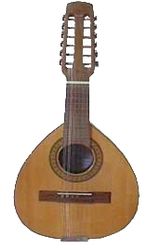Bandurria
 |
|
| String instrument | |
|---|---|
| Classification | Plucked chordophone |
| Hornbostel–Sachs classification |
321.321 and 321.322 (Necked bowl lute for roundback, necked box lute for flatback) |
| Related instruments | |
| mandolin, mandore | |
The bandurria is a plucked chordophone from Spain, similar to the mandolin, primarily used in Spanish folk music, but also found in former Spanish colonies.
Prior to the 18th century, the bandurria had a round back, similar or related to the mandore. It had become a flat-backed instrument by the 18th century, with five double courses of strings, tuned in fourths. The original bandurrias of the Medieval period had three strings. During the Renaissance they gained a fourth string. During the Baroque period the bandurria had 10 strings (5 pairs).
The modern bandurria has 12 strings (6 pairs). The strings are tuned in unison pairs, going up in fourths from the low G#. The lowest four strings are a major-third above those of a standard guitar and the highest two strings are a fourth above a standard guitar, i.e. G♯, c♯, f♯, b, e and a.
Bandurria (front view)
Bandurria (back view)
Bandurria (tailpeice)
Bandurria (tuning head)
Juan Ruiz first mentioned the term "mandurria" in the 14th century in his "Libro De Buen Amor." After that, Juan Bermudo gave the description of the bandurria in his "Comiença el libro llamado declaraciõ de instrumentos" as a three-string instrument in 1555, but he also mentioned other types with four or even five strings. In the early 1870s, a child's wake was accompanied with the bandurria music in Jijona, Alicante Province. The zapateo, a dance derived from the Spanish zapateado and introduced by tobacco cultivators from the Canary Islands, is accompanied with bandurria and other instruments before 1900.
The Philippine harp bandurria is a 14-string bandurria used in many Philippine folkloric songs, with 16 frets and shorter neck than the 12 string bandurria. This instrument probably evolved in the Philippines during the Spanish period, from 1521 to 1898. The Filipino bandurria is used in an orchestra of plucked string instruments called rondalla. It is tuned a step lower than the Spanish version, that is, low to high: F# B E A D G.
...
Wikipedia
